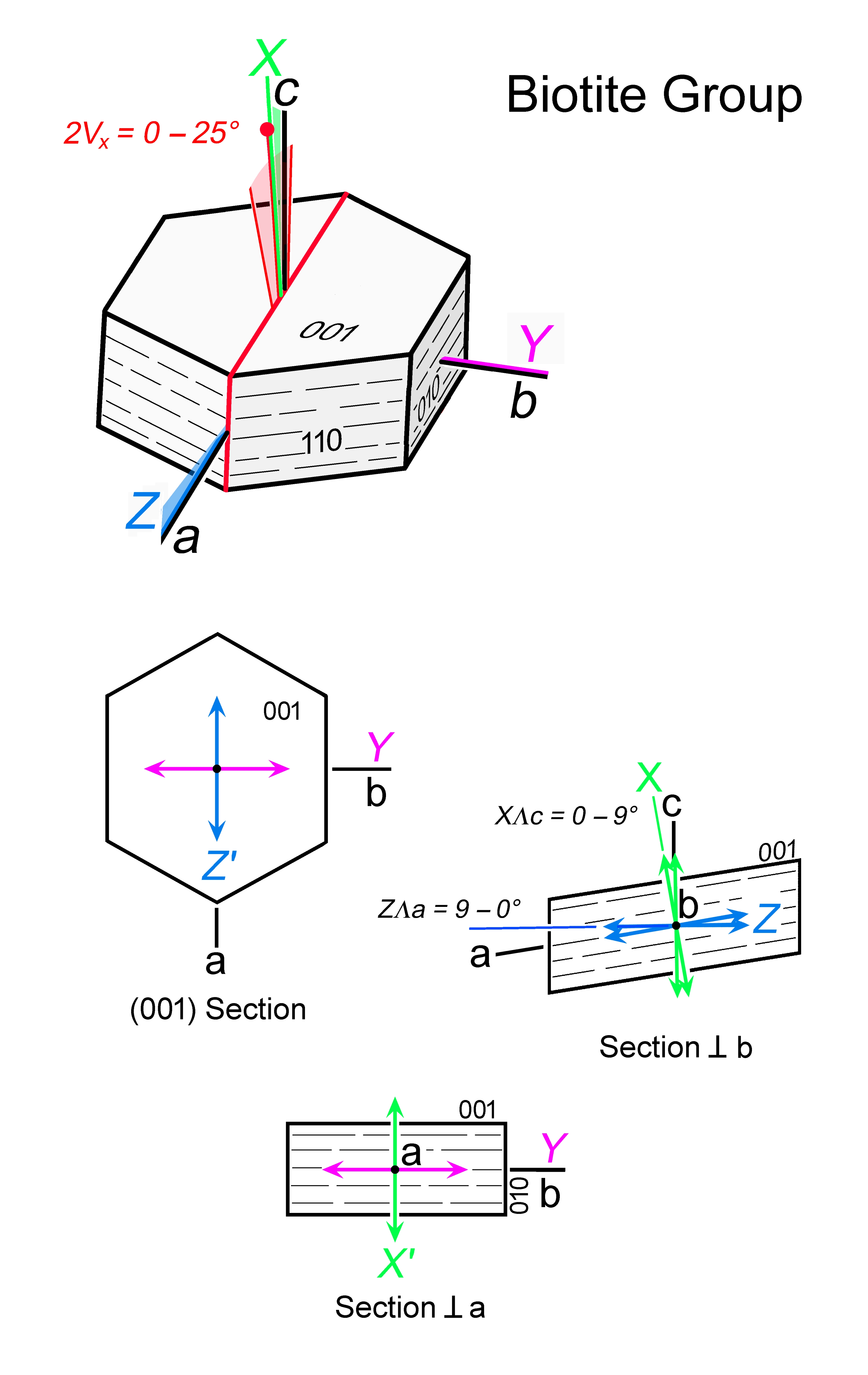|
| Formula | K(Mg,Fe,Al)3(Si,Al)4O10(OH,F)2 |
| | Optic class & sign | Biaxial negative |
| | Optical orientation | a near Z, b = Y, c near X |
| | Optical plane | (010) |
| | Relief | Low negative to high; commonly moderate positive |
| | Refractive indices | nx = 1.522 -1.655
|
|
ny = 1.548 -1.696
|
|
nz = 1.549 -1.697
|
|
| n increases with increasing Fe2+, Fe3+, Ti; n decreases with increasing substitution of F for OH |
| | Birefringence (max.) | 0.027 - 0.081 |
| | | Δn increases with increasing Fe2+, Fe3+, Ti |
| | Optic Angle
| 2Vx
= 0 - 35° |
| | 2Vz
|
| | Sign of elongation | Length-slow, l (-) in sections at a high angle to (001) |
| | Interference figure | Acute bisectrix figures with multiple isochromes in sections ⊥ c. Intense mineral colour can mask interference colours. |
| | Colour / pleochroism | Commonly intensely coloured and strongly pleochroic with Z ≈ Y >> X. Colour reflects the proportions and mixing of Fe3+ (red-brown), Ti (orange) and Fe2+ (green) members in the solid solution. Extreme absorption: black in Z ≈ Y. Phlogopite shows weak colour and pleochroism. |
| | Zoning | |
|
|
| Form | Habit | Flaky, platy |
| | | Surface | Typically subhedral with well-developed (001) crystal faces |
| | Cleavage | (001) perfect |
| | Twinning | Twinning on {001}; may be present, but can only be observed in sections close to (010) if extinction to cleavage traces deviates from 0°. |
| | Extinction | Straight or nearly straight to (001) traces; max angle ca. 9°. Characteristic “bird’s-eye-maple” structure |
|
|
| Reaction textures | Late-stage magmatic biotite rimming mafic minerals in intrusives; hydrous breakdown product of garnet, orthopyroxene and cordierite. |
| | Alteration / decomposition | Typical alteration products are chlorite, hydrobiotite and vermiculite. Alteration can lead to precipitation of rutile arranged as a regular grid of three intersecting sets of needles at 60° to each other, parallel to the basal (001) cleavage of biotite. |
|
|
| Occurence | Ign | Silicic and alkalic plutonic rocks, pegmatites, rhyolites, quartz latites, leucite-bearing volcanics, lamprophyres, peridotites, kimberlites. Late-stage magmatic product in intermediate to mafic intrusives |
| | | Met | Phyllites, schists, gneisses, granulites, impure marble |
| | | Sed | Not stable in surface environments; partly weathered flakes my occur in immature sediments |
| | | Hyd | Altered mafic rocks, hydrothermal veins |
| | | Other | |
|
|
| Distinctive properties | Habit, single perfect cleavage, colour and pleochroism, high Δn. “Bird’s-eye-maple” structure. Distinct pleochroic halos around minerals containing radiogenic isotopes (e.g., zircon, monazite, allanite). |
| | Additional comments | “Bird’s eyes”: see under muscovite. 2M1 biotite polytypes are less common than 1M and have their OP in the same orientation as muscovite.
Being a common mineral, biotite may be used for a quick check of the lower polarizer orientation in the microscope (if not known). The direction of max absorption subparallel to (001) indicates the orientation of the polarizer.
|
|
|

 Images
Images 


 Images
Images 
